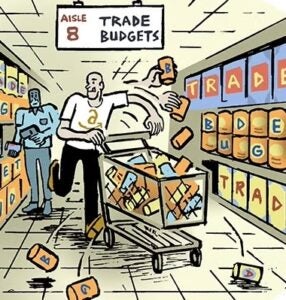 “The Video Audience” is a column written by members of the media community and focused on the evolving world of online video advertising.
“The Video Audience” is a column written by members of the media community and focused on the evolving world of online video advertising.
Today’s column is written by Teg Grenager, Founder and VP of Product at adap.tv.
Online video advertising spending continues to grow rapidly, and it’s easy to see why. It’s practically the perfect medium for brand marketers, combining the power and engagement of television ads with the targeting, tracking, and interactivity of online advertising. High-quality online video advertising creates greater value for advertisers, earns higher CPMs, and is in high demand. There’s just one problem: five years after the debut of YouTube, buying advertising in online video continues to be fraught with headaches for advertisers, publishers and everyone in between. Buyers can’t buy enough suitable online video ad space to satisfy their campaign goals or fulfill their budgets, and many publishers continue to have large amounts of unsold inventory.
What’s wrong, and what can be done to fix it?
1. Standardization of Ad Serving Protocols You’re probably thinking that video formats need to be standardized, and that once everyone uses VAST it will work fine. But the problem lies a bit deeper. The IAB did the right thing in defining VAST, but one of its greatest strengths – the fact that it was designed to be flexible and accommodate variation – is also its greatest weakness. VAST specifies the language (XML schema) to transmit ad information from an ad server to a video player, but it does not specify which variations a publisher’s video player should support. All too often a publisher and an advertiser both support VAST and yet are unable to run the tag. The reasons for this abound: encoding, bitrate, and aspect ratio of the video files themselves; formats in which the companion banner is specified (iframe, JS, HTML, image, etc.); and lack of support for multiple video files or multiple companions, “wrapper ads” or even particular tracking events. These technical details are the primary barrier to wider spending, since buyers limit their campaigns to publishers and ad networks without trafficking problems.
- What’s the solution? We could wish that the IAB had opted for a standard that was less flexible and easier to support, such as “image” tags, before we all figured out how to make JS tags work. However, in the absence of that, we need to (1) standardize around the small subset of VAST that we actually need, and (2) build an exhaustive set of VAST test ads which can run in any player to prove that it really does conform; a simple “linear ad with companion” where we restrict to a progressive download FLV creative with iframe companions, and a subset of the tracking events that we really need, like impression, click, and ad completion.
2. Trusted Video Ratings Another barrier limiting advertiser spends in online video is the “brand safety” issue. Most viewing is on user-generated video (although professionally-generated video is rising quickly in the mix) and many brand advertisers are steering clear and claiming that they can’t buy enough reach in online video.
- What’s the solution? The industry needs trusted third parties to monitor and classify user-generated video assets so that context-sensitive brand advertisers can confidently place their ads. These companies could play a role similar to that which DoubleVerify, AdSafe, and others are playing in display. Imagine being able to buy extensive reach on YouTube, MySpace, Metacafe, and others, while ensuring brand-safe content. Better yet, imagine that you could easily put your ad only on user-generated videos with particular qualities: like TV-quality, kid-safe, etc. Although this sounds like a daunting task, it is possible. Zipf’s law tells us that the overwhelming majority of viewership on any given day is happening on a small fraction of the overall video assets, a set of videos which would be easy to classify using a combination of both automated and manual processes.
3. Better Standard Ad Formats Let’s assume that we figure out how to make the basic “linear ad with companion” run properly from a wide range of ad servers into a wide range of video players. This still falls far short of delivering advertisers the full value of online video. It is an interactive medium, after all, and the repurposed 15 and 30 second television spots being used today are hardly interactive. Hulu and others have demonstrated the power of interactivity, and even at a small degree, just giving viewers a choice of ads greatly increases their level of engagement. Imagine the brand impact of ads that include gaming elements, which are more interesting than the video you originally clicked to watch.
- What’s the solution? The IAB digital video committee designed the VPAID standard for just this purpose – it allows a video player to display an arbitrarily interactive ad from an advertiser. However, this isn’t the full solution because advertisers still need a menu of standard interactive ad units for which it’s easy to design new creatives. Publishers need to define which creative units they are comfortable putting in front of their viewers for each of their sites and audiences. In other words, the industry needs to (1) settle on a couple of levels of interactivity, (2) categorize each ad accordingly, and (3) have easy tools for building new creatives for each of them. Then VPAID can be used to effectively deliver them.
4. Better Tools for Buyers Advertisers who want to buy online video ad space face many difficulties. First, they can’t use their standard media planning tools because they don’t properly categorize the video content and audiences. They often make custom Excel spreadsheets of trusted publishers and ad networks and their target audiences and accepted ad formats. Second, they still haven’t figured out how to reliably use their own third-party ad server (such as DFA or Atlas) to independently serve and track all of the important metrics. Instead, they email video files to their partners for each campaign and ask for daily or (more commonly) weekly reports of impressions and clicks. Third, because they are frequently working with ad networks (because of the ad server standards issue above) they don’t get much transparency into the delivery and performance by site and by audience segment. They need this information in order to optimize their campaign and make better buying decisions in the future.
- What’s the solution? Inventory aggregators such as ad networks and ad exchanges must provide buyers with better media planning tools, so they can pick sites and placements that match their inventory goals; a greater degree of transparency into delivery and performance; and tools for optimizing their campaign for the performance metrics that matter. Aggregators should empower buyers to use their own third-party ad servers. This requires solving the ad server standards issue above so they can closely monitor and manage delivery, as well as rotate creatives. Finally, buyers should be able to import and target the audience segments that they are currently building up and using in their display ad campaigns, functionality that will be enabled with technologies such as real-time bidding.
To sum it up, in order for online video advertising to realize its potential, the industry needs to push for standardization around a small subset of VAST, embrace third parties to monitor and classify popular user-generated video assets, and develop better ad formats and buyer tools. Once the industry tackles these challenges, nothing will be able to stop the advertising industry from taking full advantage of this amazing new medium.
Follow adap.tv (@Adaptv) and AdExchanger.com (@adexchanger) on Twitter.











